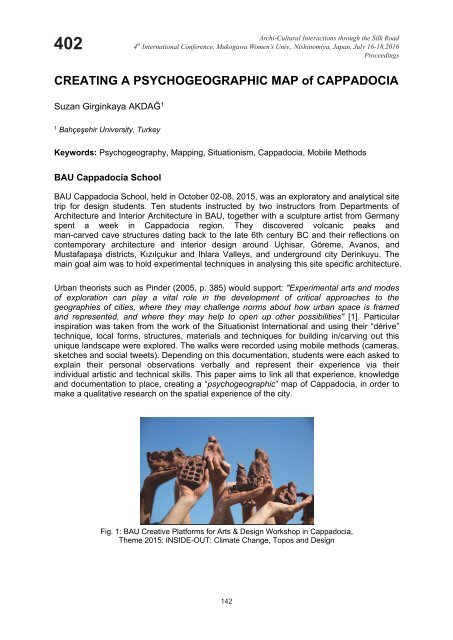iaSU2016_proceedings_402
iaSU2016_proceedings_402
iaSU2016_proceedings_402
Create successful ePaper yourself
Turn your PDF publications into a flip-book with our unique Google optimized e-Paper software.
<strong>402</strong><br />
Archi-Cultural Interactions through the Silk Road<br />
4 th International Conference, Mukogawa Women’s Univ., Nishinomiya, Japan, July 16-18,2016<br />
Proceedings<br />
CREATING A PSYCHOGEOGRAPHIC MAP of CAPPADOCIA<br />
Suzan Girginkaya AKDAĞ 1<br />
1<br />
Bahçeşehir University, Turkey<br />
Keywords: Psychogeography, Mapping, Situationism, Cappadocia, Mobile Methods<br />
BAU Cappadocia School<br />
BAU Cappadocia School, held in October 02-08, 2015, was an exploratory and analytical site<br />
trip for design students. Ten students instructed by two instructors from Departments of<br />
Architecture and Interior Architecture in BAU, together with a sculpture artist from Germany<br />
spent a week in Cappadocia region. They discovered volcanic peaks and<br />
man-carved cave structures dating back to the late 6th century BC and their reflections on<br />
contemporary architecture and interior design around Uçhisar, Göreme, Avanos, and<br />
Mustafapaşa districts, Kzlçukur and Ihlara Valleys, and underground city Derinkuyu. The<br />
main goal aim was to hold experimental techniques in analysing this site specific architecture.<br />
Urban theorists such as Pinder (2005, p. 385) would support: "Experimental arts and modes<br />
of exploration can play a vital role in the development of critical approaches to the<br />
geographies of cities, where they may challenge norms about how urban space is framed<br />
and represented, and where they may help to open up other possibilities" [1]. Particular<br />
inspiration was taken from the work of the Situationist International and using their “dérive”<br />
technique, local forms, structures, materials and techniques for building in/carving out this<br />
unique landscape were explored. The walks were recorded using mobile methods (cameras,<br />
sketches and social tweets). Depending on this documentation, students were each asked to<br />
explain their personal observations verbally and represent their experience via their<br />
individual artistic and technical skills. This paper aims to link all that experience, knowledge<br />
and documentation to place, creating a “psychogeographic” map of Cappadocia, in order to<br />
make a qualitative research on the spatial experience of the city.<br />
Fig. 1: BAU Creative Platforms for Arts & Design Workshop in Cappadocia,<br />
Theme 2015: INSIDE-OUT: Climate Change, Topos and Design<br />
142
Psychogeographic Maps by Situationists<br />
Psychogeographic mapping is used by planners and designers, as a technique to bring<br />
together personal narratives about urban space hence allowing new interpretations of urban<br />
landscape. In Naked City (1957), Debord and his colleagues questioned the conventional<br />
logic of mapping the city and constructed an alternative geography that favored the<br />
marginalized, and often threatened, spaces of the urban grid [2]. Torn from their<br />
geographical context, areas were woven together by arrows inspired by the itineraries of the<br />
“dérive.” The “psychogeographic” maps proposed a fragmented, subjective, and temporal<br />
experience of the city as opposed to the strict gridal perspective of the planimetric map.<br />
Although the Situationists most likely regarded these maps as a record of the drift and a<br />
means for provoking new tactics for inhabiting the city, they also represented a valuable<br />
schema for creating new forms of cartography.<br />
Fig. 2: The Naked City, a psychogeographic map by Guy Debord (1957)<br />
Creating A Psychogeographic Map of Cappadocia<br />
De Certeau (1974, p. 97) argued that “the act of walking ... is to the urban system what the<br />
speech act is to language [3].” Similar to Bassett’s Psychogeographic Experiments [4],<br />
students were asked experiment with the Situationist vocabulary of uniteÂs d'ambiences-<br />
( area of particularly intense atmosphere), plaques tournantes (stations on the drift, junctions<br />
in the flow), pentes(slopes), passages, axes, borders and defences, paths of attraction and<br />
repulsion etc., extending them with suggestions of their own. They were asked to think about<br />
ways of representing the hard and soft phenomena of the city (feelings, senses of calm or<br />
dislocation, attractions and repulsions etc) with different audio-visual forms: sketches, maps,<br />
photographs and video recordings to capture the sense of place, thus generating a visual<br />
and aural record of their progress as a kind of `walkscape' [5]. It was suggested they might<br />
also capture meanings and sensations of place through their associations with certain `found<br />
objects' such as postcards, artefacts etc., which they could collect during their progress.<br />
They were urged to think of imaginative ways of communicating their experiences (Figure 3).<br />
143
Fig. 3: Creating a walkscape in Cappadocia<br />
Cappadocia emerged as a critically important site for city walking experiences due to its<br />
complex stone formation and continuously transforming sillhouette driven by man-made and<br />
climate-driven factors. The historic context together with modern architecture adapted to this<br />
vernacular architectural style offered various spatial qualities. For understanding place and<br />
creating an archive of experiences geo referencing and mobile methods: such as GPS to<br />
identify locations, orient oneself in the city, turned out to be indispensable inputs. Figure 4<br />
shows a sample poster work who representing air balloon trip experience. Psychogeography<br />
demands new forms of cartography. New digital technologies for global positioning, mapping,<br />
information sharing and storing promise various tools for representing spatial experience and<br />
creating psychogeographic maps.<br />
Fig. 4: Air balloon trip- Spatial experience and mobile methods<br />
144
References<br />
[1] Pinder, D 2005, Visions of the city: utopianism, power and politics in twentieth century urbanism,<br />
Edinburgh University Press, Edinburgh.<br />
[2] Debord G., The naked city : illustration de hypothèse des plagues tournantes en<br />
psychogéographique, 1957<br />
[3] de Certeau, M 1974/1984, The practice of everyday life, vol. 1, University of Minnesota Press,<br />
Minneapolis.<br />
[4] Bassett, K, 2004 Walking as an Aesthetic Practice and a Critical Tool: Some Psychogeographic<br />
Experiments, Journal of Geography in Higher Education, 28:3, 397-410<br />
[5] Careri, F. (2002) Walkscapes: Walking as an Aesthetic Practice (Barcelona: Gustavo Gili).<br />
145


